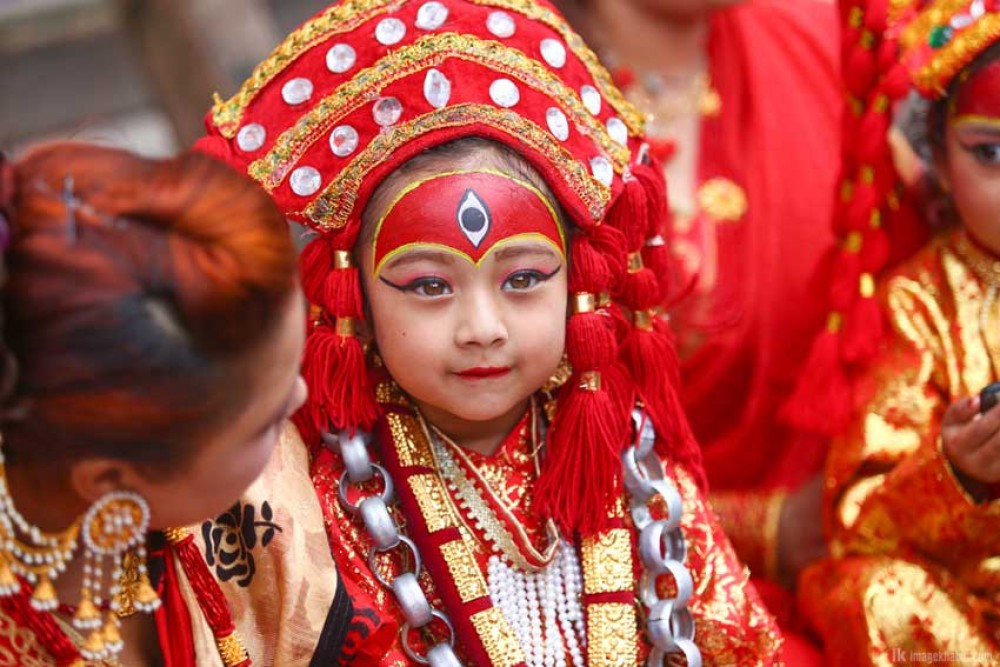Kumari : The Living Goddess In Nepal

Kumari ,The Living Goddess
Kumari,is the term referred to the living goddess in Nepal,in Newari Community. It is the culture of worshiping you girls before pubescent period as female deity or a female energy in Hindu tradition. Kaumarya,the sanskrit word meaning “Young” is the origin word of Kumari. The Nepalsese Newari Buddhist Community,specifically Shakya cast chooses Kumari,a young prepubescent girl. But she is not worshiped by every Hindus,She has more priority in Newari Community . Even there is Jatra for Kumari called “Kumari Jatra”.
Nepal is a unique confluence of Hinduism and Buddhism. Buddha is taken as the incarnation of Lord Vishnu. Similarly, Goddess Taleju Bhavani is revered as a virgin goddess according to Buddhist rites. The Temple and Buddhist Bihar are equally revered by people of both Hindu and Buddhist sects. It has become a center of devotion and faith for both religions equally. The living virgin is Vajradevi for Buddhists and Bhavani for Hindus.Goddess of power and prosperity in both forms. Buddhists and Hindus alike pay homage to this living goddess.The respectful worship of the virgin by the Shah dynasty kings from the Mallakalin period and keeping the pilgrimage tradition of the goddess intact with royal honors can be considered as a sign of the original culture of the country.

Kumari ,The Living Goddess
From the state level to the grassroots level, all the kings / subjects show the same devotion and worship. The annual Kumari Jatra and the Tika Prasad from the hands of Goddess Kumari on the occasion of the great national festival Dashain is a rare royal tradition in the world. Apart from this, the cultural tradition of Kumari is also the meeting point of Buddhism and Hinduism. It is also working as an ethnic tolerance for Nepal. For this reason, the reputation of the living Goddess Kumari is very meaningful for us Nepalis who believe in religious tolerance and cultural unity.
In the history of Nepal, during the Indrajatra festival, on the day of Kumari Rathjatra, The historical significance of Indrajatra is even greater as in 888 (accordingly 1825 BS) the Gorkha king Shri 5 Bada Maharaja Prithvinarayan Shah entered Kathmandu and laid the foundation stone of modern Greater Nepal. On the same day that Kathmandu was subjugated, His Majesty King Prithvinarayan Shah received the Tika from the hands of the Virgin and received the offerings. Shri 5 Prithvinarayan Shah considered the tradition of Indrajatra as the mainstream of Nepali culture. Nepal, which was falling apart at that time, became united against the backdrop of cultural traditions and unity. Nepali caste became a flower garden of four castes and thirty six castes. All the people of the valley enthusiastically participate in the Kumari Jatra, while Shivamargi Newar and Buddhamargi Newar play an equally important role in this program. The upper castes of both classes join in the worship while the lower castes pull the chariots. This task is done by dividing the different castes into different tasks and keeping them united.

Kumari ,The Living Goddess
The participation of Shivamargi Newar in fulfilling the same obligation by establishing the girl child of Dhamargi Newar as a goddess gives a sense of ethnic purity in the Newari community. It is believed that Jayaprakash’s reign was extended for 12 years due to his special worship of Kumari, chariot ride and construction of a separate house.In Nepali culture, the princess of Basantapur has received as much respect as the living goddess, while the Bhaktapur and Patan virgins have not received as much respect. There is a historical reason behind this. When Prithvinarayan Shah entered Kathmandu after conquering the valley, he received offerings from Basantapur Devi on the day of Kumari Jatra. Prithvinarayan Shah had announced that he would always conduct the Kumari Jatra on the day of his entry.
This is also the reason behind the faith, trust and respect of the Shah dynasty kings towards the virgin. Since this incident, every year on the day of Kumari Jatra, it was customary for the king to come to the Basantapur Gaddhi meeting and receive blessings from the hands of the Kumari by taking Tika and Prasad from the hand. As she is worshiped by the state, the virgin of Basantapur is called a ‘princess’.

Kumari ,The Living Goddess
Comment Here!